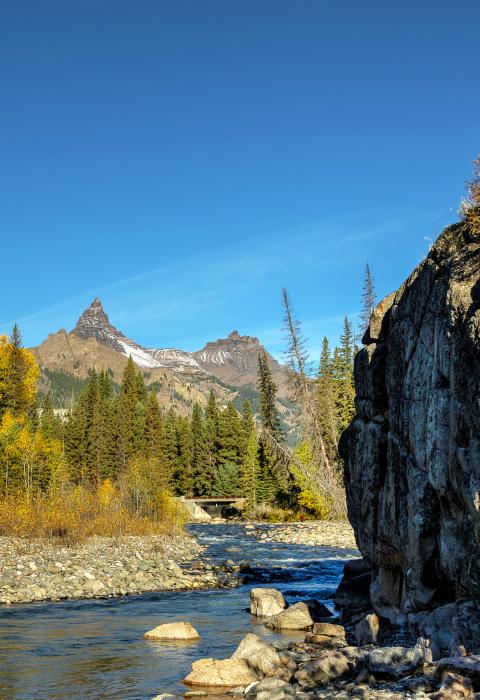Clarks Fork River
Wyoming
This river segment runs alongside the breathtaking Chief Joseph State Scenic Byway and the Beartooth All American Highway. These scenic highways carve a trail through untouched wilderness towards the peaks of Yellowstone National Park.
The river hosts wildlife habitat for many species, including grizzly bears, gray wolves, moose, elk, deer, and smaller animals. The area offers world-class fishing and hunting opportunities. Dramatic waterfalls are found within the inner gorges, though few visitors trek the harsh and rugged terrain to access them.
Most access is by wildlife, “volunteer,” and other lightly defined paths; otherwise, access to the river shores is by overland orienteering. Much of the river bottom and/or gorges are inaccessible to traditional hikers. This river segment offers a high-quality wilderness experience without the formal “wilderness” designation. Neither special access permit regulations nor fees are in effect. Review the Shoshone National Forest travel management maps and brochures prior to planning any motorized vehicle access.
Designated Reach
November 28, 1990. From Crandall Creek Bridge downstream to the north boundary of Section 13, T56N, R104W at Clarks Fork Canyon.
Outstandingly Remarkable Values
History
The Clarks Fork is named after William Clark of the Lewis and Clark Expedition.
In 1877, Chief Joseph and the Nez Perce eluded the U.S. cavalry in a 1,300-mile chase from Oregon to Montana. Although their exact route is unknown, they are said to have escaped through the mouth of the lower canyon, thus avoiding a cavalry detachment waiting on the plains to the east.
The Nez Perce (Nee-Me-Poo) Trail, a designated National Historic Trail, roughly follows the scenic byway and is an important historic resource in the greater Clarks Fork area.
Historically, the greater Clarks Fork River area has served as an important transportation artery. Native Americans indigenous to the area west of the Continental Divide were using this area as a route to reach the buffalo hunting grounds of the Great Plains. The nearby Dead Indian Pass may have been in use as early as 1700 BC and is only about two to three miles south of the river corridor.
In 1869, gold was discovered along the upper Clarks Fork River and a mining camp was established, later to become Cooke City, Montana.
Recreation
Although traditional forms of water-based recreation are limited, the canyon provides high potential for challenging and superb whitewater kayaking. The Middle Canyon of the Clarks Fork (The Box) is recognized as one of the ultimate whitewater challenges in the northern Rockies, because of its spectacular scenery, challenging rapids, arduous portages, and long length. The “Honeymoon Section” just upstream offers less challenging rapids that appeal to a broader range of the paddling community. The lower Clarks Fork features yet another great whitewater run, a relatively popular road-accessible Class IV/V section.
Recreation/tourism based on natural beauty, relative solitude, and the opportunity to view natural settings and wildlife abound in the river corridor. The canyon provides opportunities for viewing spectacular scenery and enjoying a unique and unusual environment, including numerous waterfalls and cascades, wet microenvironments, deep and narrow canyon walls, boulder floodplains, sand dunes, and wind-blown juniper krummholz. It is a rugged and primitive mountainous/canyon area that is home to populations of special species of wildlife, including elk, bighorn sheep, black and grizzly bears, wolf, cougar, moose, coyote, bobcat, pine marten, beaver, golden and bald eagles, osprey, and peregrine falcon.
Scenery
The overall setting has stunning vistas of mountain scenery, magnificent geologic features and landforms, and outstanding opportunities for wildlife viewing (bears, wolves, mountain goats, other big game). Deep chasms, soaring cliffs, and whitewater combine to provide outstanding scenery in the canyon. The tumultuous whitewater is occasionally broken by deep, slick water pools. The geology, vegetation, and wildlife combine to create the scenic beauty of the area; vistas are in a relatively wild and natural state. The Chief Joseph Scenic Byway parallels the wild river corridor for about 20 miles, providing viewing opportunities for those less adventurous.

